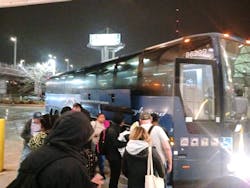Momentum for expanding intercity bus service is growing among states, new study shows
DePaul University’s new report, Back on the Bus: 2024 Outlook for the Intercity Bus Industry, strikes an optimistic tone about an industry known for major brands such as FlixBus, Greyhound, Megabus and Trailways. The study concludes that demand continues to recover from the pandemic, and public policies have begun to swing in the sector’s favor.
“Intercity bus service may have lacked the clout of airlines, Amtrak and public transit operators on Capitol Hill and in state houses in the recent past, but that is changing,” noted Joe Schwieterman, a co-author of the study.
The change is being fueled by the success of state-supported intercity bus systems, mounting evidence that bus and Amtrak service planning should be done in tandem, and a growing appreciation of the hardships facing disabled and lower-income travelers who rely on bus travel.
Policymakers' interest in intercity bus service is being stimulated by the success of smartly branded intrastate networks, such as Colorado’s Bustang, Ohio’s GoBus, Virginia Breeze and Travel Washington in the Pacific Northwest. Federal funding through the 5311(b) program, which focuses on rural areas and small cities, has also been substantial and has helped reduce the financial burden of improving bus services.
North Carolina has become a leader in state-support bus service, having expanded the number of daily roundtrips in its state-supported system from nine to 12 since 2021. Two new federally subsidized routes are part of the mix. The study notes that its bus miles of service have expanded by 50 percent, and ridership on existing routes has increased by 37 percent during the past year. Among the state’s relatively new routes is Mid-State Express, a service that links Winston-Salem and Fayetteville, with stops in Lexington and High Point. North Carolina’s Charlotte to Wilmington (via Fayetteville) route has become its best-performing route in terms of ridership, cost per trip and subsidy per trip.
Meanwhile, efforts to jointly plan bus and train services are also accelerating as more governments tear down the barriers between them. In California, Oregon, Pennsylvania, Washington state, Vermont, Wisconsin and other states, bus services are listed alongside trains on Amtrak’s booking site (amtrak.com). The Infrastructure Investment and Jobs Act (IIJA) is encouraging more of this type of integration. Although the IIJA will spur some competing train services, the study considers the legislation a “net plus” for intercity bus lines. Awareness of the opportunities to expand service is enhanced by Transcor Data Services’ new Network Transportation Information tool, which maps the routes and station stops for more than two dozen lines. The tool helps planners evaluate the breadth of the country’s bus network.
The shuttering of Greyhound stations around the country is also spurring public agencies to pay attention to bus travel issues.
“Government agencies are feeling pressure to help find solutions,” noted Schwieterman.
Some of the recently closed station facilities were owned by independent real-estate entities who found other uses for the property, while others proved too costly to maintain. Station closings in Cincinnati and Columbus, Ohio; Chattanooga and Knoxville, Tenn.; Houston, Texas; Little Rock, Ark.; Louisville, Ky.; Philadelphia, Penn.; and Tampa, Fla., during the past several years have generated a swirl of media coverage and, in some cases, public outcry. In each case, bus lines relocated to spaces with fewer conveniences, public transit connections and amenities. In most cases, municipal governments did little and, in some cases, became openly hostile to efforts to find a new location.
This year brings fresh concerns that stations in Chicago, Ill.; Cleveland, Ohio; Dallas and El Paso, Texas; Kansas City, Mo.; Orlando, Fla.; and Richmond, Va., will be closed. The study points to the new Atlanta Greyhound Station, which was built with support from the State of Georgia, as a prototype for other cities. Opened in phases in 2023, it boasts natural light from its large windows, a food stand with a grill, spacious restrooms and a digital departure board. Airport-style seating with power outlets, USB chargers, armrests with cupholders, and cushioning add to passenger comfort. Used by Greyhound, FlixBus and Southeast Stages, the station also boasts convenient rapid transit connections to downtown Atlanta and Atlanta Hartsfield International Airport.
These developments, along with the advocacy efforts of the United Motorcoach Association, the American Bus Association and the IIJA, hold promise for a more favorable era of public policy for intercity bus lines.
The Chaddick Institute at DePaul University has a free webinar on its new Intercity Bus Outlook report on Thursday, February 22, 2023, from 2 – 2:50 pm CT. To register, click here. To access the report (PDF), click here. To join its Intercity Bus Listserv or reach the study team, contact [email protected].



